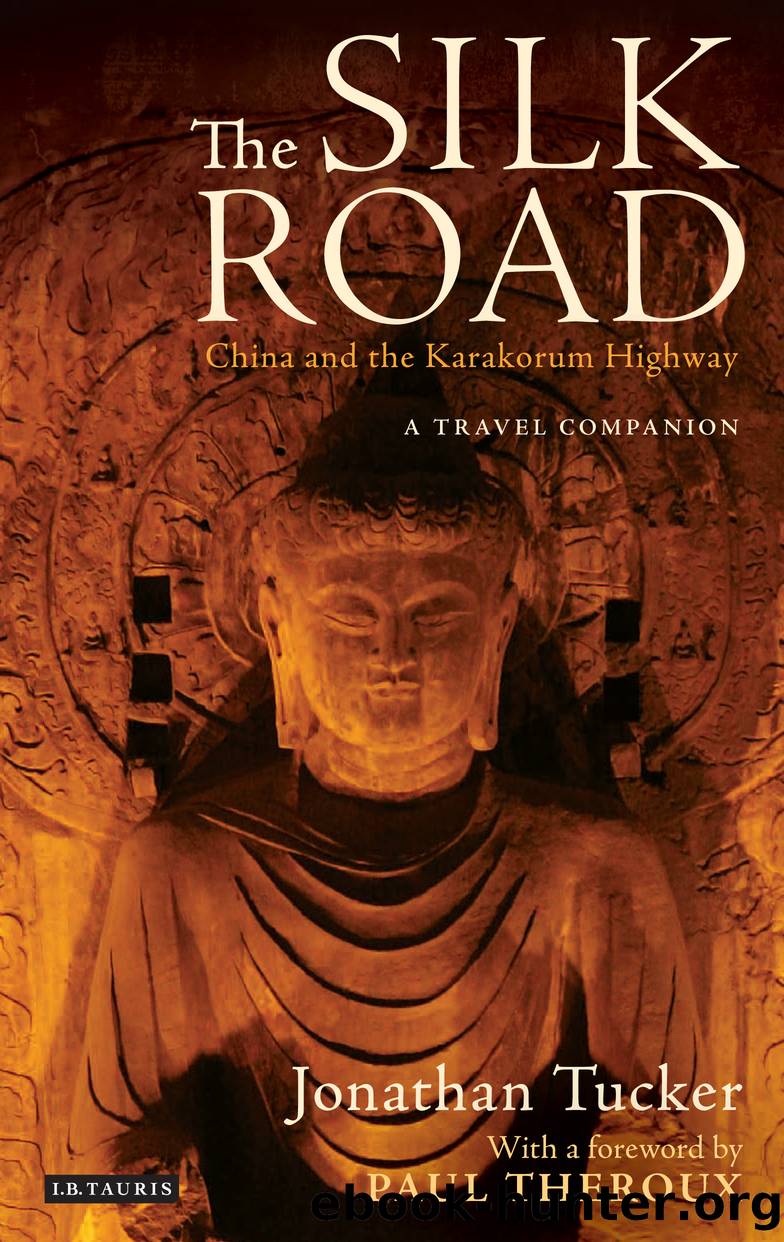The Silk Road--China and the Karakorum Highway by Jonathan Tucker

Author:Jonathan Tucker
Language: eng
Format: epub
ISBN: 9780857739339
Publisher: Bloomsbury Publishing
Published: 2015-11-15T00:00:00+00:00
Figure 19
Remains of the fort at Yumenguan (Jade Gate Pass). Han dynasty (206 BCâ AD 220). Dimensions: 28 x 28 m.
MAP 7
The Northern and Southern Silk Roads through Western China.
The road to the south-east from Yumenguan to Dunhuang is equally desolate. Early travellers must have gazed at a road that stretched endlessly before them and been overwhelmed by a sense of hopelessness.
The gateway to the Southern Silk Road is Yangguan, built during the Han dynasty (206 BCâAD 220) and situated about 70 km south-west of Dunhuang. Yangguan, or the âGate of Yangâ, is said to derive its name from Yang Ming, an official of ancient times who fled through the gate to evade a warrant for his arrest. The remains of a citadel can still be seen at the site and so many artefacts are strewn around the area â coins, arrowheads, pottery shards and even gold jewellery â that the local people call it âCurio Depotâ or âRelic Bankâ. To the Chinese it was a remote, forbidding spot â a place for farewells:
A morning rain has settled the dust in Wei Town,
Willows1 are green again in the tavern dooryard
Wait till we empty one more cup â
West of Yang Gate thereâll be no old friends.
(Wang Wei (701â62), âA Song at Wei Townâ)
By the end of the Tang dynasty the incursion of sand and flood had led to the abandonment of the area and Yangguan was forgotten. Yumenguan and Yangguan were gateways to the Western Regions, and Chinese beliefs in the evils that awaited travellers to these areas go right back into antiquity. To the Chinese, the lands to the west were terra incognita and were inhabited by monsters:
O Soul, go not to the West
Where level wastes of sand stretch on and on;
And demons rage, swine-headed, hairy-skinned,
With bulging eyes;
Who in wild laughter gnash projecting fangs.
O Soul, go not the West
Where many perils wait!
(Attributed to Qu Yuan, Ta Chao (âThe Great Summonsâ), third century BC. Translated by Arthur Waley, in Waley, 1941)
Another version runs:
O soul, come back! For the west holds many perils:
The Moving Sands stretch on for a hundred leagues.
You will be swept into the Thunderâs Chasm, and dashed in pieces, unable to help yourself;
And even should you chance to escape from that, beyond is the empty desert,
And red ants as huge as elephants, and wasps as big as gourds.
The five grains do not grow there; dry stalks are the only food;
And the earth there scorches men up; there is nowhere to look for water.
And you will drift there for ever, with nowhere to go in that vastness.
(Attributed to Qu Yuan,2 Chao Hun (âThe Great Summonsâ), third century BC)
The northern and southern routes of the Silk Road skirt the rim of the Tarim basin. This extends over an area of 530,000 km2 (about 15 times the size of Taiwan), across Xinjiang, Chinaâs largest and westernmost province. The basin is almost completely enclosed by mountains: the Tianshan to the north, the Kunlun to the south and the Pamirs to the west. Within the Tarim basin is the Taklamakan, Chinaâs largest desert and some 337,000 km2 in extent.
Download
This site does not store any files on its server. We only index and link to content provided by other sites. Please contact the content providers to delete copyright contents if any and email us, we'll remove relevant links or contents immediately.
Kathy Andrews Collection by Kathy Andrews(10506)
The remains of the day by Kazuo Ishiguro(7542)
Spare by Prince Harry The Duke of Sussex(4188)
Paper Towns by Green John(4163)
The Body: A Guide for Occupants by Bill Bryson(3789)
Be in a Treehouse by Pete Nelson(3206)
Harry Potter and the Goblet Of Fire by J.K. Rowling(3025)
Goodbye Paradise(2949)
Never by Ken Follett(2872)
Into Thin Air by Jon Krakauer(2695)
The Remains of the Day by Kazuo Ishiguro(2614)
The Genius of Japanese Carpentry by Azby Brown(2602)
The Cellar by Natasha Preston(2592)
Drawing Shortcuts: Developing Quick Drawing Skills Using Today's Technology by Leggitt Jim(2528)
120 Days of Sodom by Marquis de Sade(2428)
Architecture 101 by Nicole Bridge(2348)
The Man Who Died Twice by Richard Osman(2289)
Machine Learning at Scale with H2O by Gregory Keys | David Whiting(2264)
Fairy Tale by Stephen King(2058)
